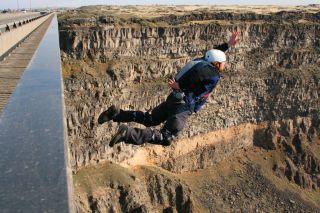
According to (the perhaps appropriately named Dr. Matt Pain and his colleague Matthew Pain in a 2005 issue of The Lancet), extreme sports are continuing to grow in popularity. I recounted my own experiences of bungee jumping in a previous blog but even that is tame compared to BASE jumping. A fairly recent 2012 paper by Erik Monasterio, Roger Mulder, Christopher Frampton and Omer Mei-Dan (2012) examined the personality characteristics of BASE Jumpers in the Journal of Applied Sport Psychology (and on which this blog is based). According to Monasterio and colleagues, BASE jumping developed from skydiving (using specially adapted parachutes to jump from fixed objects). The acronym ‘B.A.S.E.’ was coined in the late 1970s by filmmaker Carl Boenish, his wife Jean Boenish, Phil Smith, and Phil Mayfield, and comprises the fixed objects that such individuals can jump off (i.e., Building, Antenna, Span [arch, bridge, or dome], and Earth (a natural formation such as a cliff). According to the Zero P website, there are only about 1,000-1,500 active BASE jumpers and less than 10,000 people have ever even made a BASE jump. Currently there are just over 1,000 people worldwide that have a BASE number. According to the Wikipedia entry, death rates from BASE jumping are high:
“BASE jumping as of 2006 has an overall fatality rate estimated at about one fatality per sixty participants. A study of 20,850 BASE jumps from the same site (the Kjerag Massif in Norway) reported 9 fatalities over the 11-year period from 1995 to 2005, or 1 in every 2,317 jumps. However, at that site, 1 in every 254 jumps over that period resulted in a nonfatal accident. BASE jumping is one of the most dangerous recreational activities in the world, with a fatality and injury rate 43 times higher than parachuting from a plane. As of 29 March 2014 the 'BASE Fatality List' maintained by ‘Blincmagazine.com’ records 228 deaths for BASE jumping since April 1981”.

Erk Monasterio and Omer Mei-Dan published a previous paper in the New Zealand Medical Journal and noted that BASE jumping was associated with a five- to 16-fold risk for death or injury when compared with skydiving. Monasterio and colleagues also reported that 72% of experienced BASE jumpers “had witnessed the death or serious injury of other participants in the sport in which 76% had at least one-near miss incident and only 6% had not sustained an injury, near-miss or witnessed a fatality from BASE jumping”. Consequently they argued that it was unsurprising widespread belief that “BASE jumpers are in some way unusual”. Given how dangerous the sport is, Monasterio and his colleagues carried out the first ever research study into the personalities of BASE jumpers, and whether such personality factors play any contributing role in why BASE jumpers do what they do. Previous research into personality and extreme sports was summarized. Below is Monasterio et al’s summary with all but two of the academic papers cited removed:
“A number of studies have investigated the relationship between personality traits and participation in high-risk physical sports; sensation-seeking is by far the most consistently-studied personality factor in the literature. Most of these studies have found that participants in high-risk sports tend to score higher on Zuckerman’s Sensation Seeking (SS) Scale compared to low risk sports participants and control groups. Zuckerman (1983) defines sensation seeking as ‘the need for varied, novel and complex sensations and experiences and the willingness to take physical and social risks for the sake of such experience’. In addition, a smaller number of studies have also considered other personality variables such as neuroticism, extraversion and conscientiousness. Castanier et al. (2010) investigated 302 men involved in high-risk sports (downhill skiing, mountaineering, rock climbing, paragliding, and skydiving) and found that personality types with a configuration of low conscientiousness combined with high extraversion and/or high neuroticism were greater risk-takers”.

What the majority of research studies examining relationships between extreme risk-taking sports and personality have done is investigate the role of sensation seeking. In Monasterio and colleagues’ view, the research carried out to date is “far too narrow as it only provides information about one aspect of personality and ignores other important personality factors that may contribute to participation in risk-taking sports and help to understand the motivation for sports risk-taking behavior in general”. Therefore, the aim of their study was to explore the possible psychobiological contribution to BASE jumping using the temperament and character inventory (TCI) developed by Dr. Robert Cloninger and colleagues in 1994.
For those of you that don’t know, the TCI is a self-report personality questionnaire that assesses both normal and abnormal variation in temperament and character. Monasterio and colleagues assessed their sample of BASE jumpers using the TCI-235 (a self-report questionnaire with 235 items assessing seven basic dimensions of temperament and character). The following text about the seven dimensions and definitions of temperament and character are taken verbatim from the paper:
“Temperament refers to the automatic emotional responses that are thought to be moderately heritable, independent, genetically homogenous and stable over time. There are four temperament dimensions:
• Novelty seeking (a tendency to activate or initiate new behaviors with a propensity to seek out new or novel experiences, impulsive decision-making, extravagance, quick loss of temper, and active avoidance of frustration).
• Harm avoidance (a tendency to inhibit behaviors with a propensity to worry in anticipation of future problems, fear of uncertainty, rapid fatigability, and shyness in the company of strangers).
• Reward dependence (a tendency to maintain behaviors manifested by dependency on the approval of others, social attachments, and sentimentality).
• Persistence (a tendency to be hard-working, industrious, and persistent despite frustration and fatigue
Character refers to self-concepts and individual differences in goals and values that can be influenced by social factors, learning, and the process of maturation. The character dimensions are as follows:
• Self-directedness (which refers to self-determination, personal integrity, self-integrity, and willpower).
• Cooperativeness (which refers to individual differences in identification with and acceptance of other people).
• Self-transcendence (which refers to feelings of religious faith, or viewing oneself as an integral part of the universe in other ways.”
Monasterio and colleagues hypothesized that BASE jumpers would score high on Novelty Seeking and score low on Harm Avoidance (compared to control data). To be included in the study sample, BASE jumpers had to have made at least ten BASE jumps, and been BASE jumping for over six months. The sample participants were recruited from international BASE jump group meetings, adventure website forums, and from personal communication among the international BASE jumping community. The final sample comprised 68 BASE jumpers (59 male; 39 single; mean age 34 years; 28 having sustained a significant injury from BASE jumping).
The results obtained were "partially in line” with the authors’ hypotheses. BASE jumpers did indeed have higher Novelty seeking scores and lower Harm Avoidance scores. They also scored high on the Self Directedness dimension. However, the mean differences compared to normative data were “modest” and their findings suggested there was no “tightly-defined personality profile” among their sample of BASE jumpers. The exception was that a 40% of the BASE jumpers had an extremely low Harm Avoidance score (compared to 5% of the control group). The authors concluded that the eight-fold increase in BASE jumpers suggests that:
“A large proportion have a temperament profile characterized by low [Harm Avoidance]. The finding of low [Harm Avoidance] is not surprising or counterintuitive, as individuals with low scores on this dimension are described as carefree, relaxed, daring, courageous, composed, and optimistic even in situations that worry most people. These individuals are described as outgoing, bold, and confident. Their energy levels tend to be high, and they impress others as dynamic, lively, and vigorous. The advantages of low [Harm Avoidance] are confidence in the face of danger and uncertainty, leading to optimistic and energetic efforts with little or no distress. The disadvantages are related to unresponsiveness to danger, which can lead to foolhardy optimism…In order to participate in extreme sports such as BASE jumping, participants require highly developed skills that can only be acquired by repeated and consistent practice over time, and after undergoing a fairly rigorous apprenticeship. As [Self Directedness] refers to self-determination and maturity, or the ability of an individual to control, regulate and adapt behavior to fit the situation in accord with individually chosen goals and values, it is unsurprising that BASE jumpers scored high on this measure. High [Self Directedness] with an emphasis on discipline and skill acquisition may also help to explain why BASE jumpers engage in risk taking behaviors by normative rather than impulsive/disorganized antisocial means (such as drug use and criminal behavior). Previous research has shown that a combination of high [Novelty Seeking] and low [Harm Avoidance] increases the risk of drug use”.

“A large proportion have a temperament profile characterized by low [Harm Avoidance]. The finding of low [Harm Avoidance] is not surprising or counterintuitive, as individuals with low scores on this dimension are described as carefree, relaxed, daring, courageous, composed, and optimistic even in situations that worry most people. These individuals are described as outgoing, bold, and confident. Their energy levels tend to be high, and they impress others as dynamic, lively, and vigorous. The advantages of low [Harm Avoidance] are confidence in the face of danger and uncertainty, leading to optimistic and energetic efforts with little or no distress. The disadvantages are related to unresponsiveness to danger, which can lead to foolhardy optimism…In order to participate in extreme sports such as BASE jumping, participants require highly developed skills that can only be acquired by repeated and consistent practice over time, and after undergoing a fairly rigorous apprenticeship. As [Self Directedness] refers to self-determination and maturity, or the ability of an individual to control, regulate and adapt behavior to fit the situation in accord with individually chosen goals and values, it is unsurprising that BASE jumpers scored high on this measure. High [Self Directedness] with an emphasis on discipline and skill acquisition may also help to explain why BASE jumpers engage in risk taking behaviors by normative rather than impulsive/disorganized antisocial means (such as drug use and criminal behavior). Previous research has shown that a combination of high [Novelty Seeking] and low [Harm Avoidance] increases the risk of drug use”.
Despite the interesting findings, there were lots of methodological limitations in the study. The sample was very small (although the authors argued that it was relatively large given the small number of worldwide BASE jumpers – in fact they claimed it included 5-10% of all the world’s BASE jumpers), self-selected (i.e., not random), and relied on self-report (which is not always the most reliable testimony). The authors also pointed out that:
“All participants who volunteered were included. This may have led to selection bias and the sample may represent a population of particularly high-risk-taking BASE jumpers as 42% had suffered serious injury and 72% had witnessed fatality or serious accident, yet persisted in the sport. BASE jumpers who had experienced prior accidents may have been more motivated to share their experience and therefore more likely to participate in the study. As the study included only active jumpers, cautious BASE jumpers, who had given up the sport following an injury or a near-miss experience, may have been excluded. Alternatively, the sampling process may have excluded particularly high-risk groups as less experienced, more impulsive and higher risk taking jumpers may have been involved in fatal accidents at earlier stages of their BASE jumping careers and therefore were unavailable for inclusion in the study…An added limitation may be the forced-choice nature of the TCI questionnaire in which participants score either true or false for each question, whereas the answer may lie somewhere in the middle”.
Despite the limitations, the study is the first of its kind and provides a benchmark on which other studies can build. Engagement in extreme sports is likely to continue despite the high risk of injury or death. Knowing as much as we can about why people engage in such risky behaviour is clearly of great value psychologically.
References and further reading
Castanier, C., Le Scanff, C., & Woodman, T. (2010). Who takes risks in high-risk sports? A typological personality approach. Research Quarterly for Exercise and Sport, 81, 478–484.
Cloninger, C. R., Przybeck, T. R., Svrakic, D. M., & Wetzel, R. D. (1994a). Basic description of the personality scales. In C. R. Cloninger (Ed.), The Temperament and Character Inventory (TCI): A guide to its development and use (pp. 19–27). St Louis, MO: Center for Psychobiology of Personality, Washington University.
Monasterio, E., & Mei-Dan, O. (2008). Risk and severity of injury in a population of BASE jumpers. New Zealand Medical Journal, 121, 70–75.
Monasterio, E., Mulder, R., Frampton, C., & Mei-Dan, O. (2012). Personality characteristics of BASE jumpers. Journal of Applied Sport Psychology, 24, 391-400
Pain, M.T., & Pain, M.A. (2005). Essay: Risk taking in sport. Lancet, 366, Suppl 1, S33–34.
Zuckerman, M. (1983). Sensation seeking and sports. Personality and Individual Differences, 4, 285–294.
Zuckerman, M., & Cloninger, C. R. (1996). Relationship between Cloninger’s, Zuckerman’s and Eysenck’s dimensions of personality. Personality and Individual Differences, 21, 283–285.




